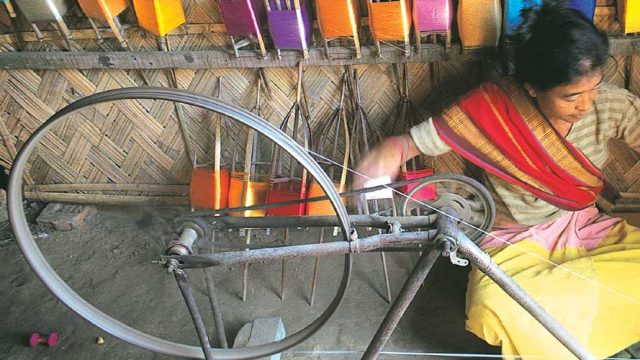For centuries, the Northeast has been a smorgasbord of various cultures, which is reflected in the rich array of handicrafts one can find here – from bamboo and cane products, to masks, wood carvings, textiles and earthernware. Tourists are bound to be awestruck by the diversity of arts and crafts of the region. While most tribes and communities have their distinctive handicrafts, the materials used to make them are largely the same.
Textiles
Cotton is the most popular fabric across the region, although Assam and Meghalaya are renowned for their silk handlooms as well. The village of Sualkuchi in Assam has been nicknamed ‘Manchester of the East’ as it is the biggest silk production centre in the region. Sualkuchi’s weavers have been creating exquisite handwoven silks such as muga, paat (mulberry) and eri, for generations. Muga has a golden hue that lends a richness to garments made from it, and lasts for years, while eri is used to make warm winter clothing. Silk is used to make saris and mekhela chador, the traditional dress of Assamese women, which consists of two pieces of cloth draped across the body. Sonidan in Meghalaya is an important centre of endi silk weaving.

Most tribes have a unique weave and the patterns vary not only within clans of the same tribe, but also from one village to another and within members of the same clan depending on their social status. Birds, flowers and human figures are some of the popular motifs that are embroidered on these handloom products.
Nagaland is renowned for its shawls, which are made of three pieces of cloth woven separately and then stitched together. The piece in the middle is decorated more than the other two, which usually have the same pattern. The shawls are largely red, black and blue and are embellished with geometrical patterns consisting of squares, lines and stripes. The various tribes of Tripura, Manipur, Mizoram and Arunachal also have a rich and diverse tradition of textiles.


Cane and Bamboo Artefacts
Bamboo and cane are integral to the culture of the region. The forests of the Northeast are abundant in bamboo and the plant is used to make all kinds of items – from houses, furniture, cradles, haversacks, containers and mats to hats (such as the Assamese japi), jewellery, musical instruments and animal traps. Bamboo artefacts from the region have become increasingly popular and are now available across India.
Wood Carving
The Konyak, Phom, Khamti, Wancho, Nocte, Tanga and Monpa tribes are renowned for their skill in wood carving. The Wancho and Morung carvings were traditionally of three kinds – those associated with head-hunting, those used to decorate young men’s communal dormitories and funerary images. The Monpas are famous for their utensils, bowls, cups and ceremonial masks. The Aos make drums sculpted from wood, sometimes using just a single log from a tree trunk. The Khamtis of Arunachal Pradesh are known for their exquisite wooden images of Lord Buddha. The Lepchas and Bhutias of Sikkim make bagschok (centre table), partition screens and chairs out of carved wood.

Metalwork
The blacksmithy and metallurgical skills of the people of the Northeast is visible in their exquisite weapons, tools, musical instruments and jewellery. The Angami and Rengma tribes of Nagaland are considered to be amongst the best blacksmiths in the region. They have a strong warrior tradition, owing to which they produced many weapons, most notably spears and daos (a kind of broadsword).
Brass is an important cottage industry in the district of Kamrup in Assam, while the Barpeta District monopolises the bell metal trade. One of the most famous products of this industry is the xorai (tray with a stand), which is used on various occasions ranging from weddings to dances and prayers.
Jewellery
Made from items as varied as gold, silver, beads, reed, bamboo, bones, feathers and insect wings, the ornaments prevalent in the region are quite unique. The tribes of Arunachal are skilled in the technique of using wax moulds to make brass and gold jewellery. The Nagas use glass shards and cowrie shells to design necklaces and elephant tusks to make bangles.

During the Ahom period, Jorhat used to be the centre of a fine enamelling work known as minakari. Enamelling is a back-breaking process, which requires superior skill but the end products are striking gold and silver rings, bracelets and necklaces. The colours used in minakari range from the traditional dark blue and green and white to the more uncommon red and yellow.
And More
The creation of masks is an important cultural activity in Assam, Manipur and Sikkim. The masks, widely used in regional and folk theatres, are fashioned from terracotta, pith (Indian cork), metal, bamboo, papier-mâché and wood.
The Dafla women of Arunachal, the Kumar and Hira communities of Assam and the Tangkhul, Poumai and Chakpa tribes of Manipur are renowned potters. Some of these communities make earthernware without a potter’s wheel, using only their hands to fashion the clay.
Terracotta craftsmen from Asarikandi in Assam have carved a niche for themselves with their one-of-a-kind style, which led to Asarikandi being branded an ethnic art in India. Sikkim is famous for its thangkas (religious scrolls depicting Buddhist mythology) paintings, carpets and blankets woven with sheep wool. In Manipur, a reed known as kauna is used to make double-weave mats.




